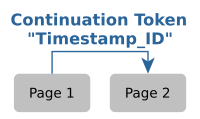
In the last post, I presented the Timestamp_Offset_Checkum continuation token for implementing web API pagination. After using them in practice for a while we discovered some drawbacks and finally came up with a new approach: Timestamp_ID. This approach is fast, scalable, efficient, stateless and easy to implement. Our pursuit of the best pagination strategy has finally come to an end.

Implementing proper pagination for Web APIs is not trivial. Offering limit and offset query parameters doesn’t cut it because this approach is slow and error-prone. But also keyset paginations with parameters like modified_since have drawbacks. Fortunately, there is a better approach: Continuation Tokens (aka Cursors). They provide fast, reliable and stateless pagination and make the client implementation very straight-forward. In this post, I propose the Timestamp_Offset_Checksum continuation token, the algorithm and point to a library simplifying its implementation.

Designing HTTP and RESTful APIs can be tricky as there is no official and enforced standard. Basically, there are many ways of implementing an API but some of them have proven in practice and are widley adopted. This post covers best practices for building HTTP and RESTful APIs. We’ll talk about URL structure, HTTP methods, creating and updating resources, designing relationships, payload formats, pagination, versioning and many more.


